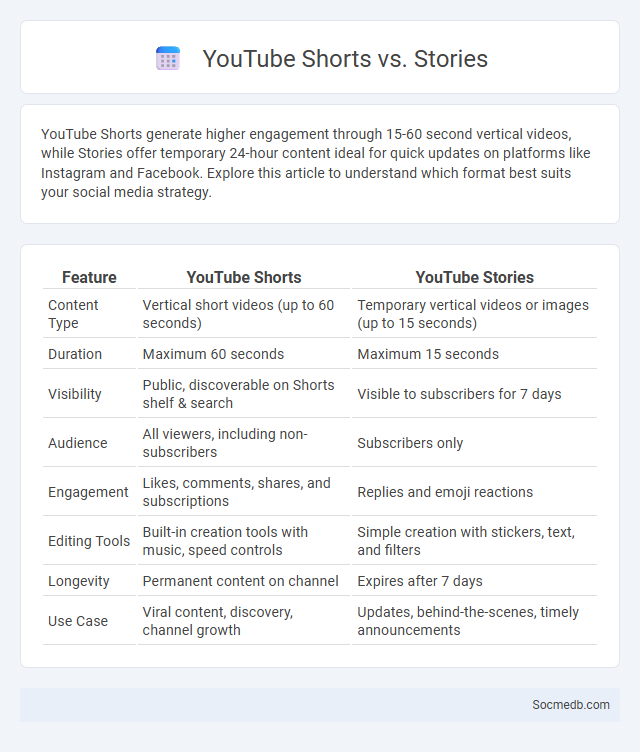
Photo illustration: YouTube Shorts vs Story
YouTube Shorts generate higher engagement through 15-60 second vertical videos, while Stories offer temporary 24-hour content ideal for quick updates on platforms like Instagram and Facebook. Explore this article to understand which format best suits your social media strategy.
Table of Comparison
| Feature | YouTube Shorts | YouTube Stories |
|---|---|---|
| Content Type | Vertical short videos (up to 60 seconds) | Temporary vertical videos or images (up to 15 seconds) |
| Duration | Maximum 60 seconds | Maximum 15 seconds |
| Visibility | Public, discoverable on Shorts shelf & search | Visible to subscribers for 7 days |
| Audience | All viewers, including non-subscribers | Subscribers only |
| Engagement | Likes, comments, shares, and subscriptions | Replies and emoji reactions |
| Editing Tools | Built-in creation tools with music, speed controls | Simple creation with stickers, text, and filters |
| Longevity | Permanent content on channel | Expires after 7 days |
| Use Case | Viral content, discovery, channel growth | Updates, behind-the-scenes, timely announcements |
Understanding YouTube Shorts: A Brief Overview
YouTube Shorts offers a platform for creating and sharing vertical videos up to 60 seconds long, designed to capture quick, engaging moments. This format leverages YouTube's vast user base and algorithm to boost visibility and audience interaction rapidly. Mastering YouTube Shorts can significantly enhance your content strategy by increasing reach and driving user engagement efficiently.
What are YouTube Stories? Key Features Explained
YouTube Stories are short, vertical video clips designed for creators with over 10,000 subscribers, lasting up to 15 seconds each and visible for seven days. These Stories offer interactive features such as stickers, music, and polls, enhancing viewer engagement and providing a casual way to share updates or behind-the-scenes content. The format allows for real-time interaction, boosting channel visibility and subscriber connection without needing full video production.
Comparing Content Formats: Shorts vs Stories
Shorts deliver rapid, engaging video content typically lasting up to 60 seconds, ideal for capturing attention quickly on platforms like YouTube and TikTok. Stories offer a more personal, ephemeral format available on Instagram, Facebook, and Snapchat, encouraging daily interaction through photos and videos that disappear after 24 hours. Choosing between these formats depends on your goal: Shorts maximize reach through viral potential, while Stories build deeper, ongoing engagement with your audience.
Audience Engagement: Which Format Wins?
Video content consistently drives higher audience engagement on social media, with platforms like Instagram Reels and TikTok boasting up to 85% more interactions than static images. Interactive formats such as polls, quizzes, and live streams also foster direct communication, increasing viewer retention and participation. To maximize Your engagement, prioritize creating dynamic, visually appealing videos combined with interactive elements tailored to Your target audience's preferences.
Duration and Design: Shorts vs Stories Breakdown
Shorts typically last up to 60 seconds, designed for rapid consumption on platforms like YouTube, while Stories usually span 15 seconds per segment, appearing on Instagram, Facebook, and Snapchat with seamless progression. Shorts leverage vertical, full-screen video optimized for quick engagement and virality, contrasted with Stories' ephemeral format that encourages real-time sharing and interactive features such as polls and swipe-ups. The design of Shorts focuses on algorithm-driven discovery, whereas Stories emphasize personal connection and daily updates within a limited 24-hour lifespan.
Monetization Opportunities for Creators
Social media platforms offer diverse monetization opportunities for creators, including ad revenue sharing, sponsored content, merchandise sales, and fan subscriptions. Leveraging these revenue streams requires consistent audience engagement and high-quality content tailored to your niche. Your ability to diversify income sources can enhance financial stability and long-term growth in the competitive creator economy.
Algorithm and Discoverability Factors
Social media algorithms prioritize content based on relevance, user engagement, and recency, impacting your content's visibility. Key discoverability factors include the use of targeted hashtags, consistent posting schedules, and active interaction with followers. Optimizing these elements increases the likelihood that your posts reach a broader, more engaged audience.
Best Use Cases for Shorts and Stories
Shorts and Stories excel in boosting real-time engagement by delivering concise, visually compelling content that captures immediate audience attention. You can leverage Shorts for viral video marketing and trend participation, while Stories are ideal for time-sensitive promotions, behind-the-scenes glimpses, and interactive features like polls to deepen viewer interaction. Both formats enhance brand visibility and foster authentic connections through ephemeral, mobile-friendly experiences tailored for modern social media consumption.
Pros and Cons: Shorts vs Stories
Shorts offer rapid content consumption with high potential for viral reach due to algorithmic favoring on platforms like YouTube, benefiting your brand visibility and engagement. Stories provide a more personal, ephemeral interaction that fosters deeper connections and authentic engagement with your audience through direct messaging and limited-time updates. While Shorts excel in discoverability and mass appeal, Stories excel in building loyal communities, making your choice depend on whether you prioritize rapid growth or sustained relationships.
Choosing the Right Format for Your Channel
Selecting the right format for your social media channel enhances engagement and aligns with your audience's preferences. Video content dominates platforms like Instagram and TikTok, driving higher interaction rates, while infographics and images perform well on platforms such as Pinterest and Facebook. Tailoring content format--whether stories, reels, or carousel posts--based on platform-specific algorithms and user behavior maximizes reach and conversion potential.
 socmedb.com
socmedb.com